Happy Sham El-Nassim,
Once again, we find ourselves in the midst of Easter, Sham El-Nassim, and Ramadan.
Even though these are official holidays, we cannot celebrate Egypt's oldest feast in the traditional manner. Most Muslims avoid eating salted fish while fasting as it can increase thirst, but we will keep the tradition of consuming salted fish and visiting public green spaces during Eid, which will take place on the weekend inshallah.
For thousands of years, Egypt has celebrated Sham El-Nassim or Shemu to commemorate not only the beginning of spring but also the harvest season.
The river Nile and agriculture played a significant role in shaping the history and traditions of Egypt, both ancient and modern. Despite the spread of Orthodox Christianity in Egypt, Egyptians did not abandon their old feast but instead shifted its date to coincide with the end of fasting after Orthodox Easter.
The Shemu feast survived the Arab rule of Egypt and the spread of Islam, and the name was eventually Arabized to become Sham El-Nassim or "Smelling the Breeze," which became a feast to celebrate spring.
Egyptians gathered and celebrated Sham El-Nassim in various places, including the Egyptian Gulf and Cairo's famous Sadd El-Barani Street.
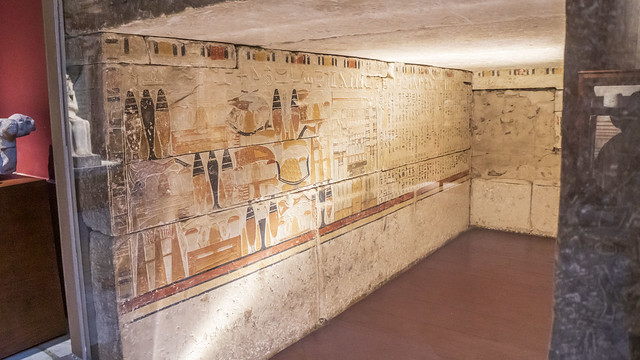 |
| Deshri's burial chamber from the first intermediate period in ancient Egypt. It was found in Giza's Saqqara featuring food and drink representing to the deceased spirit in the afterlife |
On the occasion of Sham El-Nassim, I am honoured to continue sharing some of the hidden gems at the Egyptian Museum of Cairo, which many visitors may overlook during their quick visit.
With more than 100,000 priceless pieces in one place “say Mashallah”, the museum holds one of the world's largest collections of ancient Egyptian antiquities.
While most tours focus on the most famous pieces, individual tours provide the opportunity to see lesser-known but more interesting pieces, such as what the ancient Egyptians used to eat.
In conclusion, despite the challenges we face, the spirit of celebration and tradition lives on in Egypt, and I feel privileged to share some of its unique cultural aspects with you.
On the occasion of Orthodox Christianity and Easter Eggs, it is interesting to note that the ancient Egyptians also used to eat eggs.
Here we have a remaining eggshell that was found in one of the tombs.
 |
| Dried figs found in Saqqara, an eggshell and grapes found in Thebes |
The ancient Egyptians were aware of eggshell decorations even before Easter. They knew how to decorate ostrich eggs since the predynastic era.
Eggs played an important role in ancient Egyptian mythology. They were revered as the origin of the world. In one version of the ancient Egyptian creation myth, the cosmic egg hatched the bird of light, while in another version, it was seen as the soul of the primordial waters.
To the left of the eggshell are dried Pharaoh figs or Ficus sycomorus, which were found in Saqqara in Giza. These figs date back to the time of the Third Dynasty in the Old Kingdom.
According to the Arabic Wikipedia, Egyptians cultivate sycamore trees to provide shade and purify the atmosphere from dust.
The sycamore tree also played an important role in ancient Egyptian mythology and belief system. It was called the "Tree of Love." The sycamore tree was thought to be a manifestation of ancient Egyptian deities Nut, Isis, and Hathor, who were given the title "Lady of the sycamore."
The tree was also used in making wooden coffins and statues. According to the late pioneer Egyptologist Salim Hassan in the first volume of his Encyclopedia of Ancient Egypt in Arabic, Osiris' coffin in his famous myth was made of sycamore.
To the right, we have ancient Egyptian grapes found in Thebes from the 18th dynasty era of the New Kingdom.
It is interesting to note that these grapes are more recent to us than the figs from the Old Kingdom.
The ancient Egyptians consumed grapes at feasts, and they were also made into wine that was usually drunk by the upper classes, including kings, nobles, and temple priests.
Grapes also played a role in the Egyptian belief system and mythology. They were seen as a symbol of resurrection and may also have played a role in the transfiguration process undertaken by kings in the afterlife.
It is speculated that this may have to do with the transformation of red grapes into red wine, which looks like blood.
Grape harvest and wine are also associated with fertility deities, just like in ancient Greece and ancient Rome.
Speaking about ancient Greece and ancient Rome, ancient Egyptians continued to incorporate wine and grapes during the Greco-Roman era.
Here is a painting of naked Bacchus/Dionysus at the Egyptian Museum of Cairo
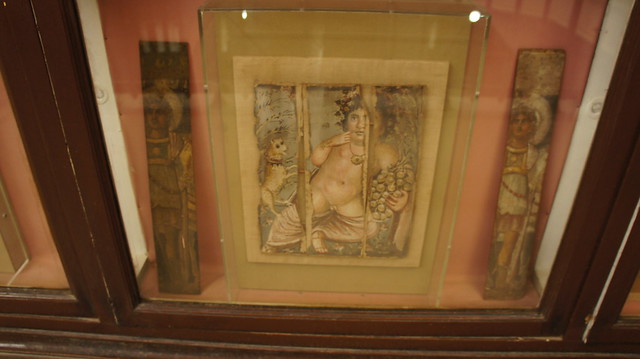 |
| Naked fat lustful Bacchus/Dionysus |
Also this Ancient Egyptian tondo from Roman Egypt.
 |
| An ancient Egyptian tondo of a young handsome man from the Greco-Roman era |
If you zoom in, you can see the grapes and eggs in this image.
That late Ancient Egyptian young man looks familiar, like a modern Egyptian.
This is the funerary mask from the Greco-Roman era of a little boy named Heraklean that was discovered in the Minya governorate.
 |
| Heraklean's funerary mask from the Greco-Roman era |
Young late Heraklean is depicted presenting grapes to a pigeon, and I wonder what that symbolized.
Again, it's remarkable how young Heraklean has identical twins in every Egyptian city now!! And they claim that modern Egyptians are not related to ancient Egyptians.
Now, returning to the topic of food in Ancient Egypt, here is the ancient Lupinus Termis, also known as lupin bean, or as it is commonly called in Egypt today, "termis" in Arabic.
 |
| Ancient Egyptian dates and lupin beans |
It was discovered in Luxor and dates back to the Roman era. However, the oldest recorded use of the lupin bean dates back to the Twelfth dynasty of the Middle Kingdom in Ancient Egypt.
Termis is another popular food item during Sham El-Nassim in modern Egypt. It is typically eaten cold with lime, and some people add chilli pepper powder.
On the left, we have a couple of dates that date back to the 18th dynasty of the New Kingdom. They were found in Thebes.
If you are a regular reader of Egyptian Chronicles, you will know that dates are a staple food item during Ramadan, and Egypt is currently the world's largest producer of dates, followed by Iraq.
The oldest recorded instance of cultivating the date palm goes back to the Neolithic era in 8000 BC in Egypt and Syria.
Dates, beer, and wine were well-known in ancient Egypt, and date wine still exists to this day in Upper Egypt.
As we have Eid El-Fitr coming up this weekend, here are some examples of biscuits from Ancient Egypt at the Egyptian Museum of Cairo.
 |
| Different types of biscuits from ancient Egypt |
During Eid El-Fitr, the famous Kahk with sugar icing is a popular treat. Some people argue that Kahk is not a biscuit, but it is actually a type of biscuit.
Eid cookies, or Kahk, are associated with the Islamic feast, but their history goes back to ancient Egypt.
Kahk is reportedly a Coptic word, but it dates back to pre-Christian times.
Carvings depicting people making Kahk were found in the ruins of temples in Memphis and Thebes, including the tombs of the 18th dynasty.
Kahk cookies were baked for Ancient Egyptian religious feasts, and they continued to be associated with religion as Egyptians converted to Christianity. It became a staple food item at Easter and Christmas, and when most Egyptians converted to Islam, it moved along with them and became another staple food item associated with Eid El-Fitr.
As a bonus trivia, to this day, Egyptians, both Muslims and Christians, must bake a certain type of pie-size biscuits and cookies called "Shurik" whenever they visit their loved ones in the cemeteries, keeping the ancient Egyptian tradition of baking "Shurik" alive. The same name is still used today.
Now, on to the most important staple food of all in Egyptian households, and any household in the world: bread.
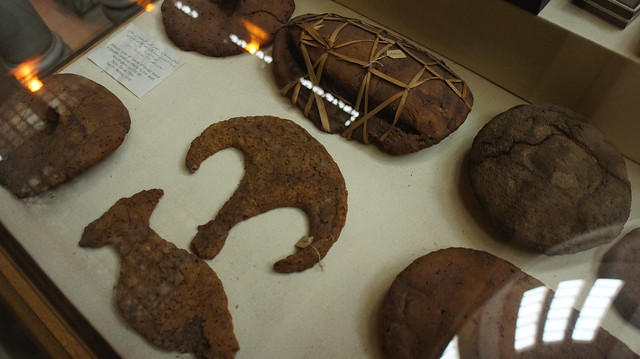 |
| Various types of bread loaves from Ancient Egypt |
Here we have various types of bread loaves that were unearthed in Deir El-Madina in Luxor in the year 1906.
In Ancient Egypt, bread was mainly made from emmer wheat unlike the variety of grains used nowadays.
This limestone statuette from the Old Kingdom depicts an ancient Egyptian bread seller.
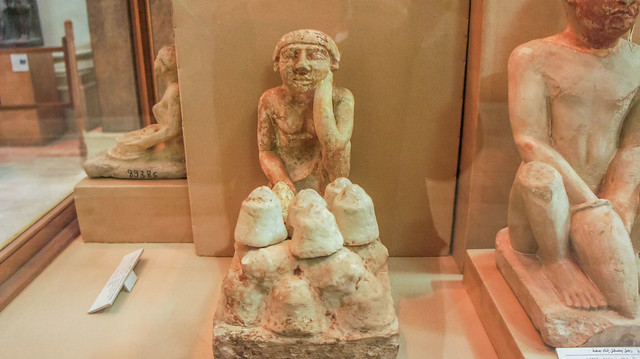 |
| Ancient Egyptian bread seller statuette made of limestone |
As far as I understand, emmer wheat was difficult to grind into flour without undergoing various stages.
This may be why we find numerous figurines in ancient Egyptian tombs depicting men and women grinding wheat in various sizes and shapes.
For example, there is a limestone statuette of Mrs Ishat that shows her grinding wheat.
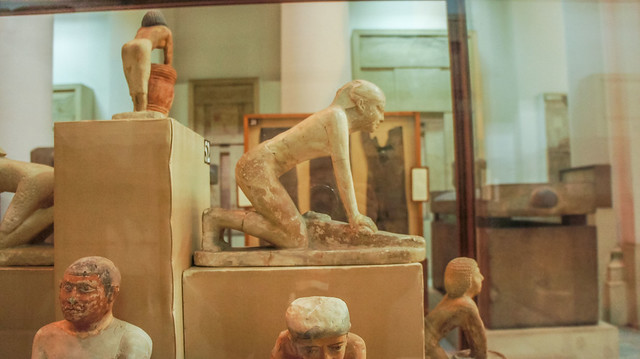 |
| Ishat grinding wheat statuette |
The statuette of the late Ishat, "May Allah bless her soul," was discovered at the Mastaba of Weirini of the 5th dynasty at Giza's Saqqara.
Ishat and other servants in Weirini's household were immortalized as statuettes to accompany him and serve him in the afterlife.
Also, here is a wooden funerary model depicting a group of ancient Egyptians who were likely involved in the process of baking.
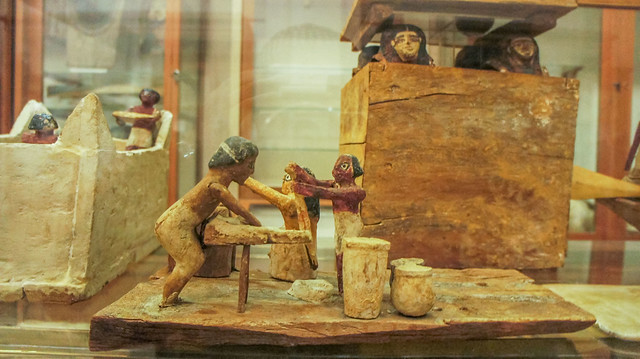 |
| A model of bakers I believe |
It's worth mentioning that in ancient times, Egypt was known as the breadbasket of the world. However, nowadays it has become the world's biggest wheat importer.
Now, some people might wonder where to find the salted fish exhibit at the Egyptian Museum of Cairo.
Don't worry, the museum has a collection of fish-related artefacts, including a depiction of Middle Kingdom fishermen fishing in the Nile.
 |
| Meketre's famous fishermen boats model |
That amazing fishing boats models were made of papyrus roots.
These amazing fishing boat models were made from papyrus roots and were found in the tomb of the Royal Steward Meketre, who began his career under King Nebhepetre Mentuhotep II of the 11th Dynasty and continued to serve successive kings into the early years of the 12th Dynasty.
The models were discovered in Meketre's tomb in Luxor in 1920 along with other models.
They are now on display at the Egyptian Museum of Cairo, as well as at the Metropolitan Museum of Art in New York. Meketre's collection of models provides a glimpse into the daily life of Ancient Egypt.
With that, I will pause our tour for now, but the Egyptian Museum of Cairo and its incredible collection are just the tip of the pyramid.
I will conclude this post with the old but not ancient national anthem of Sham El-Nessim in Egypt and the late sweet Soad Hosny singing “It is Springtime”
All the photos in this post were taken by Sony Nex-5 except the first photo of the post. It was taken by Sony a6500. All the photos were photographed by an e-mount lens (18-55mm)

No comments:
Post a Comment
Thank You for your comment
Please keep it civilized here, racist and hateful comments are not accepted
The Comments in this blog with exclusion of the blog's owner does not represent the views of the blog's owner.